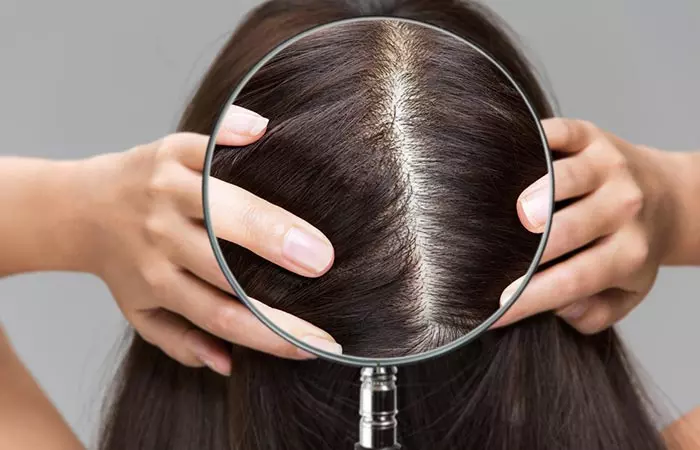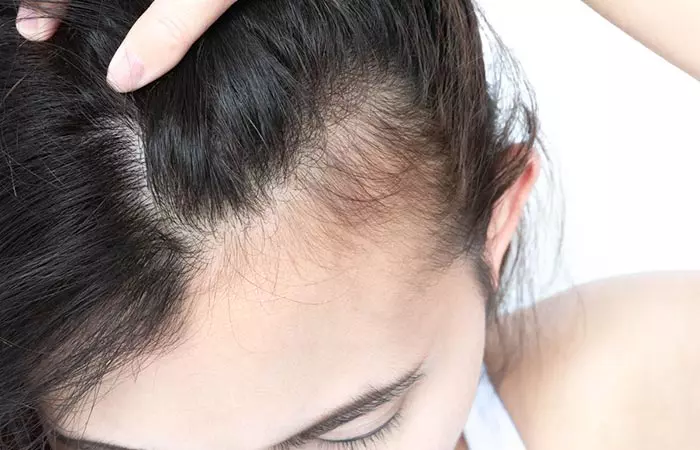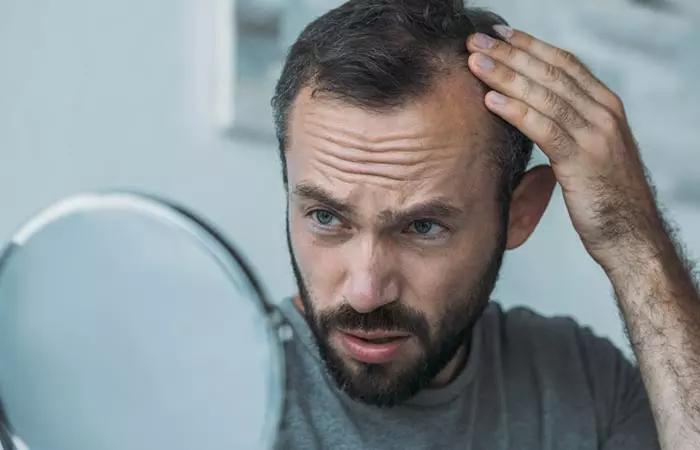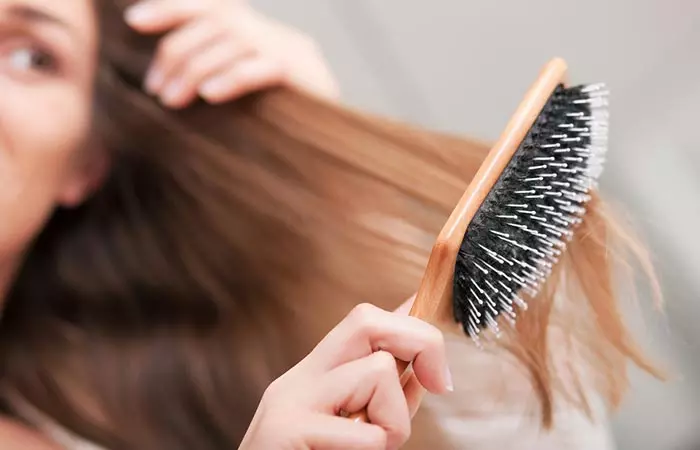The 5 Signs Of New Hair Growth
Part your hair, down the middle and away from your face, and check your scalp under proper lighting. Take time to inspect the roots, scalp, edges, and hairline, especially the area close to the forehead. If you have not colored your hair, you will easily notice the signs of hair regrowth. Look out for:
1. Dark Spots Or Shadow
If you have dark hair, look closely for dark spots or specks. These are often referred to as a “shadow.” These dark spots indicate that your hair follicles are in the active phase of hair regrowth. The spots look dark because of the color pigment (melanin) in the hair shafts about to grow in the anagen phase (2).
2. Fine and Short Hair Growth
If you notice fine and baby hair strands on your scalp, it is a sign of hair regrowth. If your scalp is healthy, these short hairs can grow noticeably faster than usual. However, these baby hair strands are delicate. Hence, pay attention and be gentle on your hair and scalp. Avoid scratching, massaging, and brushing aggressively.
3. Fuzz
When hair starts to regrow, it appears like fine “peach fuzz.” It is usually translucent and thinner than the rest of the hair on your scalp. If you recently underwent surgery or had a head injury and are worried about hair growth on the bald spot, the appearance of peach fuzz is a positive sign. It means the hair follicles on that lesioni A structural or biochemical change in a tissue or an organ of the body incurred due to a disease or a wound. are active.
4. Strong Hair
Strong hair is one of the most important signs of healthy hair growth and indicates further new hair growth. The growing hair strands become active in a few months. They gain volume and grow longer and are not breakage-prone. This is a clear sign that your scalp is healthy to initiate hair regrowth.
5. Soft And Manageable Hair
If your hair has become easier to manage, it is a sign of new and healthy hair growth. A healthy scalp supports healthy hair growth, and healthy hair is always soft and manageable. This is more noticeable in people who have undergone hair loss due to a health condition. Once you start recovering, you take vitamin supplements and consume a healthy diet for hair growth (3). This improves your overall health and hair health. Let’s look into some convenient ways to grow your hair faster at home.
How To Grow Your Hair Faster
As mentioned earlier, maintaining good hair health is fundamental for faster and healthier growth. The following solutions may help you achieve the same:
Nutrient-Rich Diet: Deficiency of multiple nutrients, such as iron, zinc, vitamins A, B, D, and E, fatty acids, selenium, amino acids, and proteins, can lead to hair damage or loss (3). Include them in your diet for good hair health. Essential Oil Treatment: Essential oils are known to have strong antifungal properties that can protect the hair from dandruff and keep the scalp healthy (4). It is one of the most popular methods to stimulate new hair growth. Samara, a blogger, shares her personal experience of battling excessive hair fall and how she found her answer in essential oils and other oils to overcome her hair care woes. She added the recipe and hair care process. For the results, she states, “Weeks turned into a month, and then another. I noticed something incredible — fewer strands on my brush and less hair left behind after a shower (i).” She further adds, “My hair felt different too — smoother, shinier, and undeniably healthier.” Topical Medication: Studies have shown that topical application of ointments such as minoxidil, spironolactone, and melatonin can help treat excessive hair loss and thinning in women (5), (6). Keratin Treatment: Keratin is an important hair protein that can help reduce hair loss, increase volume, and repair damaged hair (7). Opt for a keratin treatment if you have damaged hair that has become difficult to manage. Consult with a Trichologist: If you notice changes in hair growth or health, consulting a trichologist can provide personalized treatment options tailored to your hair needs.
Apart from these, you can also make some lifestyle changes and adjust your hair care routine to maintain your hair growth rate. There are so many different ways to make your hair grow faster naturally that involve making only minor tweaks to your routine. Follow them and watch your hair stay happy and healthy! One thing that confuses many is how to differentiate between baby hair and a strand that is broken or damaged. We will help you learn to identify the difference in the next section.
Distinguishing Between New Hair Growth And Breakage
- Appearance New Hair Growth New hair appears soft, fine, and shorter than the surrounding strands. It may appear more frail but is actually a healthy new hair strand. Breakage Broken hair strands are usually uneven and can appear shorter, frayed, or split at the ends. They may also feel rough or brittle.
- Location New Hair Growth New growth is often more concentrated around the hairline and parting, as well as the crown of the head. It can be identified by the presence of tiny, fine hairs in these areas. Breakage Breakage can occur at any point along the hair shaft but is most common at the ends. You might notice pieces of hair on your shoulders or in your brush that are significantly shorter than the rest.
- Texture New Hair Growth The texture of new hair can be softer and less coarse than mature hair. It may also be curlier or straighter than the existing hair, depending on genetic factors. Breakage Hair that has broken will often feel dry, rough, or brittle. You may notice that it lacks elasticity, leading to frequent snapping when stretched. Adapting your hair care routine based on these observations will help you promote healthy growth and reduce breakage. What lifestyle changes can support hair growth? Check out the infographic below to learn how to make an easy flaxseed hair mask for your new hair.Illustration: StyleCraze Design Team Going for regular exercise, proper hydration, and stress management techniques can significantly benefit hair growth by improving overall health and circulation. How long does it take to notice new hair? Dr. Hyemin Pomerantz, a board-certified dermatologist, says, “It depends on what type of hair loss you are experiencing and whether the treatment you are receiving is effective. Hair grows slowly, even if it’s to return about 0.2 to 0.5 inches a month. It may take 3-6 months until noticeable hair growth.” Does itchy hair mean it’s growing? According to Dr. Pomerantz, “An itchy scalp does not necessarily mean new hair is growing. Itching is usually from inflammation in the scalp’s skin, and it can actually mean there is inflammation that can cause hair loss.” How many new hairs grow in a day? “If there is no hair loss condition, we grow 50-100 hairs a day. This is about the same number of hair we lose each day,” says Dr. Pomerantz. What are the three stages of the hair growth cycle? Dr. Pomerantz states, “The three stages of the hair cycle are anagen, catagen, and telogen. Anagen is commonly called a growing phase, where hair follicles continue to grow larger and deeper into the scalp to be able to support the growing hair strand. During the catagen phase, the hair stops growing, and the hair follicle becomes detached from the blood supply. Hair falls out during the telogen phase. After the follicle stays in the resting phase for 3-4 months, it returns to the anagen phasei The most active and longest phase of hair growth where the cells in the hair divide rapidly so as to form new hair. .” Can hair grow back after thinning? According to Dr. Pomerantz, “Hair regrowth depends on what type of thinning you have and whether you stay on effective treatments. There is reversible and irreversible hair loss. In reversible hair loss, hair can come back after months of appropriate treatments. Among reversible hair loss conditions, telogen effluvium (hair loss following a stressful event like surgery, post-partum, or illness like COVID) can stop on its own without treatments, and hair can grow over time.” Does hair shedding mean new growth? Hair shedding typically means some hair strands have reached the exogen phase of hair growth, which means their lifespan has ended. Once the hair sheds, new hair starts growing. Does hair grow back if the root comes out? Yes, hair does grow back, but it may take time as a new hair follicle needs to grow in place of the old before the hair shaft springs out. However, if the hair does not grow back, you should consult a trichologist as it could be a sign of a medical condition. Why is my hair growing so slow? Hair can grow slowly because of multiple reasons, like aging, hormonal changes, and stress. Unlock the secrets to determine if your hair follicles are alive with this informative video. Gain valuable insights and take steps to optimize your hair health. Watch now and embrace healthy, vibrant hair.












